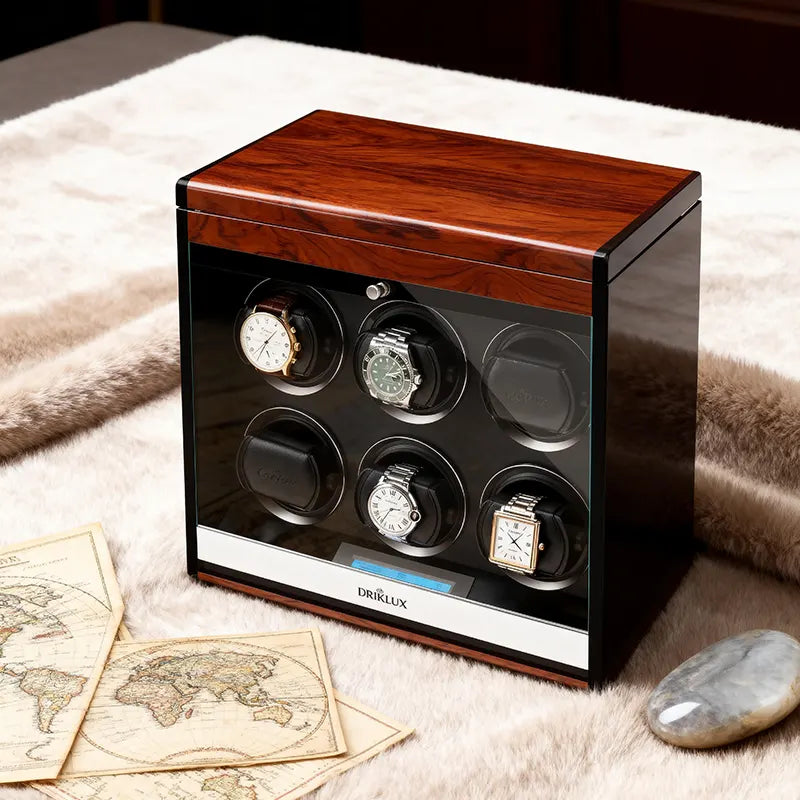Watch Winder vs. Drawer: How Lubricant Dynamics Affect Watch Longevity
For any automatic watch owner, proper care is paramount to ensuring a lifetime of precision and reliability. A frequent question is whether it's better to store a timepiece on a watch winder or let it rest in a drawer. The answer lies deep within the watch's movement, in the complex world of lubricant dynamics. How you store your watch directly impacts the behavior of these essential oils and, ultimately, its long-term health.
Understanding Lubrication in Automatic Watches
At the heart of every mechanical watch are dozens of tiny, moving parts. To prevent friction and wear, watchmakers apply specialized lubricants to critical points in the movement. These oils are the lifeblood of the watch, ensuring that gears turn smoothly and pivots rotate with minimal resistance. However, over time, these lubricants can age, dry out, or migrate, leading to decreased accuracy and potential damage. Regular maintenance is crucial to keep these lubricants in optimal condition.
How Watch Movement Affects Lubricant Behavior
Lubricants in a watch are designed to perform best when in a state of balanced, consistent motion, much like the movement provided by a human wrist. This dynamic state helps keep the oils evenly distributed across the components they are meant to protect. When a watch is static, the lubricants can begin to settle, pool in certain areas, or even dry out, leaving critical parts unprotected.
Watch Winders and Their Impact on Lubrication
A quality watch winder is designed to simulate the gentle, periodic motion of the wrist. By keeping the watch moving, a winder helps maintain the ideal state of lubricant distribution.
- Benefits: The consistent rotation ensures that lubricants remain fluid and evenly spread, preventing the "settling" that occurs during static storage. This keeps the watch ready to wear and its movement properly lubricated.
- Potential Risks: Using a low-quality winder or incorrect settings can be detrimental. Excessive, continuous motion could potentially displace lubricants or cause unnecessary wear. That's why choosing a winder with programmable Turns Per Day (TPD) and rotation settings is essential.
Drawer Storage: Static Conditions and Lubricant Challenges
Storing a watch in a drawer means it remains motionless for extended periods. This static condition poses several risks to lubricant health:
- Lubricant Pooling and Drying: Gravity can cause oils to drain away from where they're needed most, or they can congeal and dry out over time.
- Increased Wear on Restart: When a watch is started after a long period of inactivity, it may run for a short time with insufficient lubrication, causing increased friction and wear on its components. This is a key consideration in the watch winder vs. watch box debate.
Comparative Analysis: Watch Winder vs. Drawer
| Aspect | Watch Winder | Drawer Storage |
|---|---|---|
| Lubricant Distribution | Kept optimal by simulated, consistent movement. | Lubricant may settle, pool, or dry unevenly. |
| Convenience | Watch is always wound and ready to wear. | Requires manual winding and setting. |
| Wear and Tear | Minimal with a quality winder and proper TPD. | Potential for increased wear upon restart. |
| Lubricant Health | Positive, as it prevents settling and drying. | Risk of degradation from prolonged immobility. |
Best Practices to Maximize Lubricant Life and Watch Longevity
To ensure your watch remains in peak condition, a balanced approach is best:
- Use a Quality Winder: Invest in a winder where quality matters. Use the correct TPD settings to provide motion without overworking the movement.
- Rotate Your Watches: If you have a large collection, rotate which watches are on the winder and which are resting. Short periods of static storage are not harmful.
- Schedule Regular Servicing: No storage method can replace the need for professional maintenance. A watchmaker should clean and re-lubricate the movement every 5-7 years.
Conclusion
When it comes to watch longevity, lubricant dynamics are key. While drawer storage is acceptable for short periods, a high-quality watch winder offers a superior environment for preserving lubricant health over the long term. By keeping the movement in a dynamic state, a winder ensures that the internal oils remain properly distributed, protecting your timepiece from the inside out and keeping it ready for your next adventure.
HOW OUR CUSTOMERS ARE TREATED:
Loyal customers not only come back, they don't just recommend you, they insist that their friends buy from you.. Profit in business comes from repeat customers; customers that boast about your product and outstanding service
















